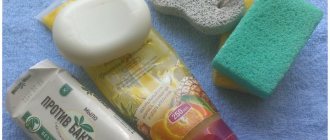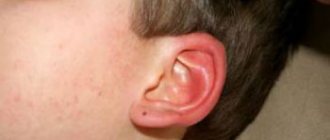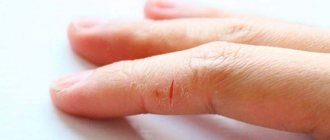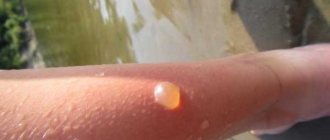A child has peeling skin on his fingers: causes and treatment
Sometimes parents notice that, without any reason, the baby’s skin begins to peel off. It looks quite unaesthetic. In addition, such symptoms may indicate pathological processes occurring in the body. That is why you should contact a specialist if you notice that the skin on your child’s fingers is peeling. The causes may be hidden in a variety of pathologies. It is almost impossible to determine them on your own, without the help of a doctor.
Skin functions
A person practically does not think about how important the role of such a cover is for the body. Skin is the outer protection. It is what prevents various infections from entering the body.
Therefore, caring mothers, noticing unpleasant symptoms, rush to find out what is causing the skin on their fingers to peel off. The reasons for this condition can be varied, ranging from allergies to serious disorders in the functioning of the body.
Protection is not the only function of the skin. The skin takes part in many processes occurring in the body.
We should not forget that the skin is one of the sense organs. After all, this is how a child perceives touch, warmth, cold, pain, pressure.
Child’s body – white spots, red spots, skin rashes
Possible diseases whose symptoms are white spots:
- Pityriasis versicolor Fungal disease of the epidermis. At the first stages it appears in the form of flaky spots of a pinkish color, and when exposed to sunlight, the spots become more noticeable and acquire a white color. Usually the location is the neck, chest, shoulders, back.
Among the reasons for the occurrence of such unaesthetic spots:
- increased sweating
- hormonal changes (typical for teenagers)
- failure to comply with hygiene rules
This disease is not dangerous. The main thing is to contact a dermatologist in time, who will prescribe the appropriate antifungal ointment.
- Vitiligo is a disease associated with abnormal pigmentation of the skin, resulting in distinct white heels that may peel. Most often, this disease is hereditary. In addition, the disease can develop after an infection, due to disturbances in the functioning of the nervous and endocrine systems, and in autoimmune diseases
Red spots appear on the body much more often and in most cases are not symptoms of serious diseases. However, the reasons for the appearance of redness may be:
- allergy
- stress
- insect bites
- infectious diseases (measles, chickenpox, scarlet fever, rubella)
Redness usually does not occur on its own without other symptoms. With the exception of cases when we are talking about temporary redness when a child cries, overheating, or nervous feelings. In other cases, red spots are accompanied by additional symptoms. Most often, this is a rash, itching, peeling, depending on the combination of which one can suspect the presence of a particular disease.
- Rashes in children , especially at an early age, are a common occurrence. For young children, redness combined with a rash may indicate the presence of heat rash, diaper rash or allergies.
- Miliaria and diaper rash are characterized by wet red spots in the folds of the skin, which arise due to excessive overheating of the child, poor hygiene
- If there is redness + rash + peeling, the vast majority are symptoms of an allergy, which the child may outgrow. In older children (after one year), rashes on the body can be the result of infectious diseases, each of which has its own symptoms and requires timely diagnosis by the attending physician
Common reasons
So, why does the skin peel off on a child’s fingers? The reasons for this phenomenon are often hidden in:
Vitamin deficiency. This problem can occur even with a perfectly balanced menu. After all, sometimes some of the vitamins are not fully absorbed in the child’s body. It is possible to determine which components are missing only after testing. Often we are talking about a deficiency of vitamin E and A. They are responsible for the elasticity and integrity of the integument. Diaper rash on the skin. It is important to properly organize the care of your baby. If diaper rash is detected, you should use special products for baby skin and completely eliminate the possibility of overheating. Childhood stress. Against the backdrop of anxiety, problems with the skin very often arise. Dysbacteriosis. It would seem, how are problems in the intestines related to the fact that the skin on the child’s fingers is peeling? The reasons for this phenomenon are the use of antibiotics. After all, most often it is this type of therapy that leads to the occurrence of dysbacteriosis. It is not difficult to cope with this pathology. The pediatrician will recommend a pharmaceutical preparation containing bacteria. Infection with parasites. It is important to worry in a timely manner: why is the skin peeling off on a child’s fingers? The reasons are sometimes hidden in helminthic infestations. And the fight against such parasites needs to be started in a timely manner.
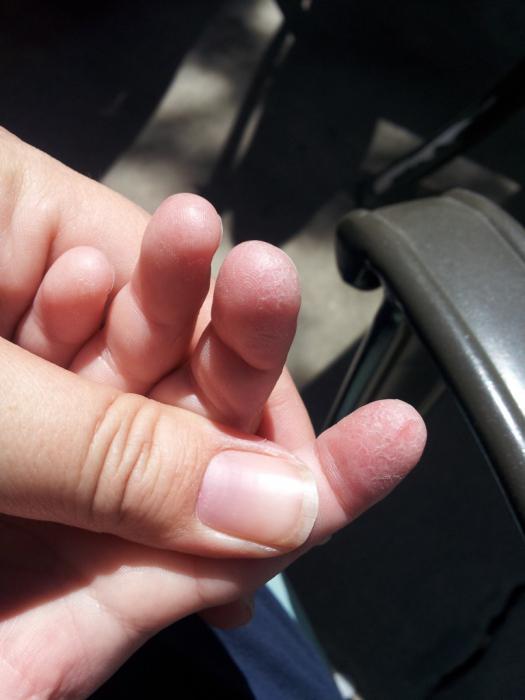
The skin of a newborn is peeling between the fingers
Normally, the skin of a healthy person is characterized by integrity, uniformity, the absence of rough or discolored spots, pimples, pustules, etc. However, a newborn baby is an exception. A newborn baby first goes through a period of adaptation to new conditions: temperature conditions, humidity levels, etc. Therefore, the presence of dry patches and excessive peeling of the skin is a completely natural and temporary phenomenon.
You can notice erythema in a child within a few days after birth. Most often, post-term babies experience this. In addition to abundant peeling, usually found between the fingers, behind the ears or on the bend of the limbs, you can notice redness, as well as toxic erythema in the form of yellowish-white pimples. After a few weeks, everything goes away on its own and does not require special measures.
If after a month the skin still peels off, or new symptoms appear, it would be a good idea to seek medical advice.
Other reasons
You should not decide on your own why the skin on your fingers is peeling. The reasons for such symptoms may lie in diseases occurring in the child’s body.
An unpleasant defect can be caused by:
- allergic reactions caused by both external and internal provocateurs; fungal infections and various dermatoses; viral diseases; staphylococcal and streptococcal infection; irradiation of the baby; pancreatic diseases.
As you can see, a variety of sources can underlie an unpleasant condition. Therefore, only a doctor, having examined the baby, can reliably say what the true reason is.
Symptoms of pathology
How to promptly identify an unpleasant condition? Parents should closely monitor the child. In most cases, the first signs of pathology are itching. At the same time, initially the baby rarely scratches his hands. Over time, the itching becomes quite annoying.
The skin becomes hyperemic and inflamed. Small blisters form on the pads. They begin to increase in size. A similar phenomenon is observed on the palms.
As a result of mechanical damage, the epithelium ruptures. The skin on the fingertips peels off in large layers. The reasons for this condition must be identified. After all, only by identifying the source can a treatment plan be outlined.
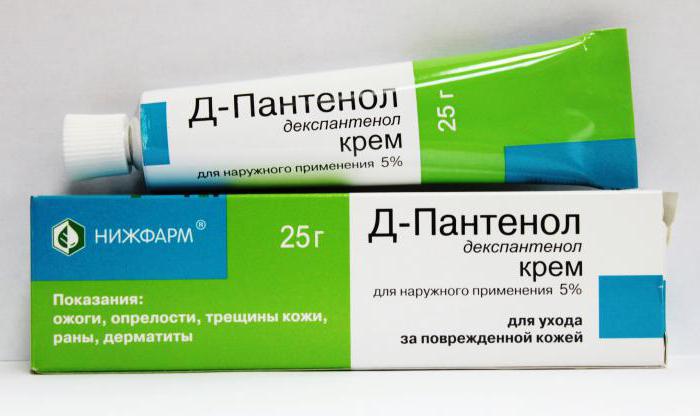
Sometimes there may be no itching at all. In this case, it is much more difficult to detect pathology in a timely manner. After all, the baby, by and large, is not bothered by anything.
Local remedies
Often, it is as a result of a lack of vitamins that the skin on the fingers peels off. Causes and treatment can only be determined by a doctor. Don't forget this.
If the source of such discomfort is a lack of vitamins, then special vitamin complexes may be recommended for the baby. They will enrich the body with exactly those substances that the baby lacks.
In addition, local remedies will provide a good effect:
It is recommended to rub them into the child’s fingers 2-3 times a day.
You can use Aevita capsules. It is necessary to carefully pierce the capsule with a needle and lubricate the baby’s fingers with the contents.
Some recommendations when you notice symptoms
It is not always possible to immediately consult a doctor if peeling skin on a child’s fingers is detected. How to behave and what to do until you receive a doctor’s recommendation? How not to cause harm?
First of all, measures should be taken to avoid infection. If a child has peeling skin on his fingers, as a rule, the child constantly scratches his fingers. It tears apart the already weak layer of skin. This increases the chances of infection. Therefore, you should wash your hands first. It is not recommended to wipe them, just blot them with a soft towel. If the child is small and cannot control himself, then wrap his fingers in a bandage. There is no need to bandage it tightly. Blood should flow to the fingers in normal quantities. Here it is important to simply avoid scratching and spreading the disease throughout the body. For kids, special gloves will be enough. But older children can already remove them, so the bandage is more reliable.
More to read: 9 Months Old Child Has Red Throat: What to Treat
Some resources recommend celandine baths or moisturizing creams. You should not do this without knowing what caused the disease. Celandine has a cauterizing disinfectant effect. If the skin is peeling due to a mite or fungus, this will help stop their work, and if this is the result of contact with chemicals, it will be even worse. It's the same with creams. If we are talking about a burn, then the cream will help. But if it is a scabies mite, then the cream will be an ideal breeding ground for it. And these are only 2 possible reasons. And there is also the effect of worms, the pancreas, etc.
If the problem is not found on all fingers, but only on some, then it is scabies or a fungal disease, so you should wrap each finger separately and hurry to see a doctor. If the doctor confirms the diagnosis, all the child’s things and soft toys that he picked up with his fingers will have to be washed at high temperature. In this case, your hands and the hands of everyone in your household should be thoroughly washed and examined. If the diagnosis of scabies or fungus is confirmed, you will have to sanitize the apartment and personal belongings, otherwise the disease will haunt you constantly. But you shouldn’t be afraid that in this case they will come from the sanitary and epidemiological station and flood the entire apartment with bleach. Only fabric and wool items are processed. The rest is enough to just wash well. For treating a sofa, for example, there are now special aerosol products.
The next stage is an analysis of causes and events. It is necessary to understand whether the cause is allergy or contact exposure. It is necessary to clearly determine whether new products (new soap or bed linen) have recently been introduced into the child’s diet. Remember the medications the child took. Speaking of medications. Read the section on the side effects of the medicine. Perhaps everything will become clear. This should be analyzed in detail, it is better to write it down, the doctor will ask about it.
Child nutrition
The basis of competent treatment is nutritional correction. Therefore, it is important to enrich the menu for a child whose fingers have peeling skin. The reasons, as noted above, are mainly due to a lack of vitamins.

Nutritionists recommend introducing into the diet:
- cereals (rye, barley, oats, corn); potato; fish oil, liver, eggs; peaches, apricots, plums; carrots, pumpkin, cabbage; dried apricots, prunes; dill, cilantro, parsley.
In addition, we should not forget that allergies can cause such a problem. In this case, it is important to exclude provoking foods.
Baby baths
Don't forget that your baby needs daily hygiene procedures if he has peeling skin on his fingertips. The reasons for this phenomenon may even lie in the lack of these activities.
Baths with oak bark, string, and celandine can provide an excellent effect. When bathing, carefully clean off damaged epithelium. Do not forget that the covers must always be kept perfectly clean. After bathing, gently dry your palms with a soft towel. It is strictly forbidden to rub them! Do not use a hard towel. This way you will only damage the delicate coverings. Be sure to lubricate your baby's hands with moisturizer. You can use local multivitamins: “Boro-plus”, “Bepanten”, “Bübchen”.
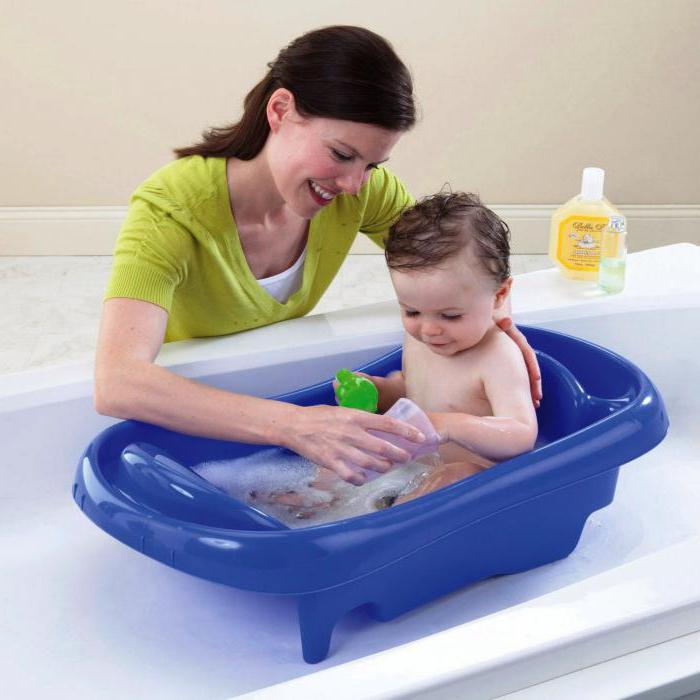
Baby skin care tips
To avoid the problems described, Dr. Komarovsky recommends preventing them by following certain rules.
Hygiene recommendations
Water procedures are a prerequisite for caring for a baby. Even if a newborn cannot crawl yet, his skin will peel when the baby is occasionally bathed. This procedure is necessary - it helps to wash away “extra” particles of the epidermis from the surface.
Since in infants the process of cell movement occurs faster, they need to be bathed more often (but not overdo it), adding decoctions of chamomile, oak bark, nettle, string or calendula flowers to the water. At the same time, choose the right soap that does not cause dry skin.
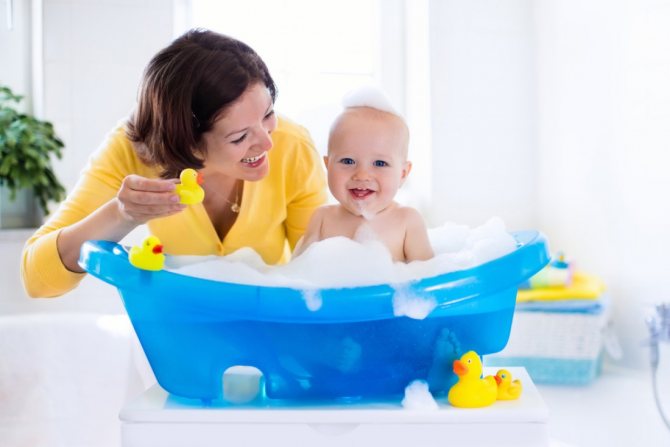
Important procedure
One of the points of hygiene is trimming nails. In newborns, the plates, although soft, are quite capable of scratching delicate skin. An infection will get into the wounds, resulting in an inflammatory process.
When the problem has already arisen, an overgrown nail aggravates the situation. When itching, the baby itches, tears the skin in the affected areas, allowing microbes to penetrate deeper into the dermis. In this case, you will have to put special gloves on the little one.
Maintaining moisture balance
Sometimes the skin can peel off because it has become too dry. The main reason here is a violation of tissue hydrobalance. The human body is 70% filled with water. The fluid is quickly consumed (excreted in the urine, sweat), so regular replenishment is required.
For breastfed babies, mother's milk compensates for the lack of moisture - it also contains a high percentage of water. With the introduction of complementary foods, the need for an additional source of fluid arises.
Note! The baby’s health directly depends on the water-salt balance. Therefore, if the little one begins to urinate a little, this is a signal that a malfunction has occurred in the body. Peeling of the skin will confirm this.
A thirsty child will not be able to explain to his mother on his own that he wants to drink. Starting from six months (earlier for artificial babies), after the main feeding, the child is given baby water in small portions.
Moisturizing creams produced specifically for babies will help maintain the hydrobalance of dry skin. They should contain linseed oil, sea buckthorn or peach.
Getting the Vitamins You Need
Each cell of the skin requires energy, which is impossible to obtain with poor nutrition. Complete mother's milk and infant formula fill the body with all the vitamins necessary for the child's development.
Note! Partial and then complete transfer of the baby to adult food can provoke vitamin deficiency, one of the signs of which is peeling of the skin.
Vitamins A and E play an important role in the elasticity of the epidermis. Therefore, carrot, pumpkin, plum, peach puree and juices should be present in the baby’s diet. When the time comes for protein complementary foods, the child is periodically given liver, fish and eggs regularly. Potatoes, oatmeal and corn porridge are useful as a side dish for the skin.
Particular attention is paid to the diet at the turn of the seasons. It is during the transition from autumn to winter and the latter to spring that the body most often experiences a deficiency of vitamins, which causes the baby’s immunity to become compromised.
Care during the cold season
Small children are always carefully wrapped up for walks in cool weather. Therefore, the risk that the little one’s hands will freeze is minimal. In this case, overheating often has a negative effect on the dermis. The child’s palms sweat a lot, disrupting the water-salt balance in the cells. Diaper rash causes itching, causing discomfort in the baby.
Children should be dressed according to temperature. At the same time, they should be warm, but not hot. Mittens are chosen from natural material that does not provoke skin friction.
ethnoscience
You can resort to old recipes. However, remember that all these measures will eliminate unpleasant symptoms caused by fairly harmless reasons. If the problem lies in illnesses, then only a doctor should prescribe treatment. No home recipes or local treatments can eliminate peeling.
The following folk remedies are very popular:
Oatmeal decoction. It perfectly eliminates peeling. It is necessary to take daily baths with a decoction of flakes. Such procedures are repeated until the skin is completely healed. Linseed oil. This component is an excellent medicine for flaky skin. It is recommended to lubricate damaged areas with oil after hygiene measures. Wheat germ extract. Another excellent component that provides skin restoration. They should lubricate the baby's hands daily.
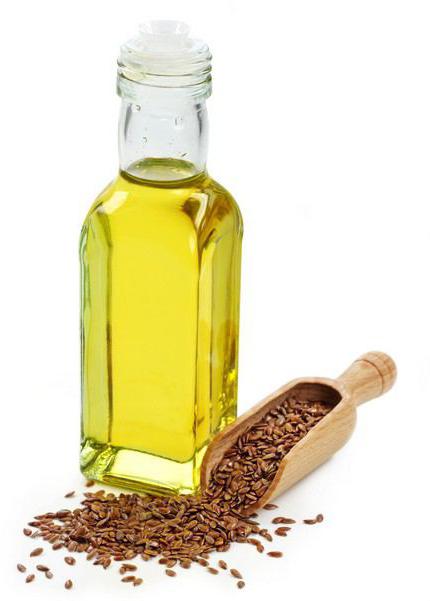
Finally, I would like to remind you once again: if you find a problem on children’s fingers, be sure to start with a visit to the doctor.
A child has peeling skin on his fingers: causes and treatment
Quite often, attentive and caring parents discover that the child’s skin is peeling off on his fingers. There are quite a few reasons leading to this condition. It is best to immediately show your baby to a qualified dermatologist. Only he will be able to correctly assess the condition of a small patient, find the reason why the skin on the child’s fingers and toes is peeling, and prescribe effective treatment. In medicine, the condition when the skin on the arms and legs peels off is called desquamation.
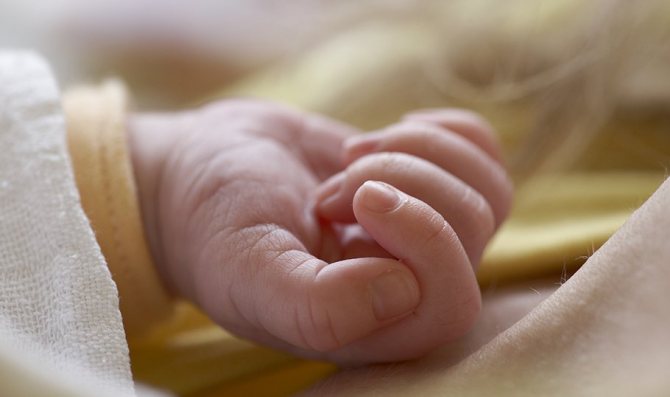
Why does my child's fingers peel off?
There are many reasons why a child may have peeling skin on his legs and arms. Let's consider all the factors that can lead to this condition:
- pancreas pathology; helminthic infestations; neurological disorders and stressful situations; frostbite of fingertips; irradiation of the child’s body; long-term treatment with hormonal, sulfonamide, antibacterial drugs; viral diseases; staphylococcal or streptococcal infection; fungal skin infections and other dermatoses; allergic skin reaction to internal or external allergens; vitamin deficiency, in particular insufficient amounts of vitamins A and E, necessary for the elasticity and integrity of the outer epithelium.
As can be seen from the above, the skin of a child’s hands peels off for a variety of reasons, and each case of such a disease requires timely diagnosis and correctly prescribed treatment, since desquamation is not an independent disease, but a consequence of other diseases or pathologies.
Treatment of diseases
In the first years of life, the skin and body of a baby are sensitive to a large number of microorganisms. In the absence of good care, tissues lose their protective properties, which often leads to diseases.
Urea-based cream intensively softens the skin. It easily fights not only rough tissues, but also cracks.
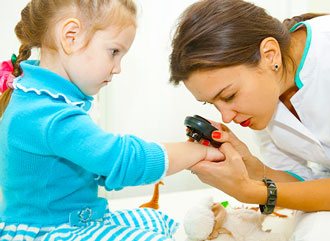
The appearance of peeling on the legs causes skin diseases in most cases. It is necessary to exclude the appearance of psoriasis. If the diagnosis is confirmed, then hormonal and moisturizing creams and pastes are prescribed, applied to the flaky surface. At the same time, medications are taken orally.
Problems with the thyroid gland are eliminated by taking medications to correct its function. For peeling due to allergic reactions, antihistamines are used. Children under one year old are allowed to be given Tavegil, Fenkarol, Donormil.
- erius;
- claritin;
- cetrin;
- Diazolin.
Vitamins A and E maintain the elasticity and hydration of tissues. In order for them to be better absorbed, it is recommended to apply a few drops to a piece of black bread and give to the baby. When cracks on the legs join the peeling, they are lubricated with nourishing and healing agents. In addition to this, the baby should wear cotton socks.
How does desquamation develop?
The skin of the child's arms and legs peels off gradually. Usually the first sign of this disease is itching. At first it is not strong, the skin itches periodically, and signs of peeling of the skin are not yet visible. Then the itching intensifies, the child scratches the skin on the fingers and toes more and more often, causing it to become inflamed and hyperemic. At this time, small bubbles without visible contents appear in the interdigital areas and on the fingertips. These blisters then increase in size, taking in more and more healthy skin. The blisters rupture due to the fact that the baby itches all the time, as the itching intensifies. After this, the child’s skin will peel off on his fingers and toes. In place of the peeling skin, new, thin, pink color appears.
There are cases when peeling of the skin of the hands is not accompanied by severe itching and therefore parents do not immediately pay attention to the fact that there are functional disorders in the child’s body. And when they finally notice, the skin peels off not on the fingers and toes, but on the palms, ankles and above. In this case, the treatment and recovery process will be delayed.
In most cases, desquamation appears in spring and winter, when a lack of vitamins begins in the child’s body. Sometimes peeling of the skin of the fingers and toes goes away on its own without leaving any marks on the skin.
Treatment with drugs and medications
Before treating your child for roughness and flaking skin, consult your doctor. He will determine the diagnosis and help you select medications.
Under no circumstances should this list include hormonal drugs. You should not start the course with such components. They can provoke a violation of the child’s internal organs and systems.
- When treating peeling skin, pediatricians and dermatologists often prescribe the drug Bepanten. The nutritional base eliminates dryness and skin disorders well. It can be used by babies from birth. Ointment and cream are available for sale. They are similar in meaning, only the ointment is considered more fatty and nutritious
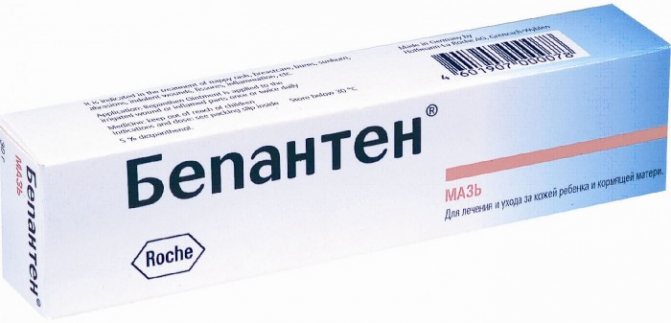
- A cheaper analogue of Bepenten is the drug Dexpanthenol. Its action is aimed at eliminating violations of the integrity of the skin. It is used from birth. The only contraindication is intolerance to the components. The drug is applied externally to the affected areas of the skin, with the exception of weeping wounds.
- Topicrem emulsion will help eliminate skin irritation after prolonged exposure to the sun, frost, and wind. It can be applied to the skin even of newborn babies. The natural components of the oil-water emulsion will help eliminate the disease in just a few applications.
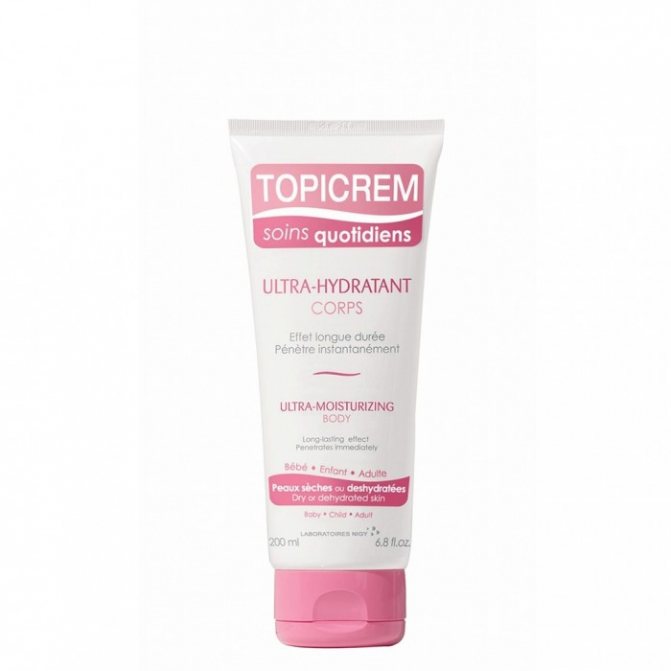
- The La-Cri series of drugs is suitable for use in children from infancy. The product does not contain hormones. Only natural base. Suitable for sensitive baby skin. Eliminates dryness, irritation, helps in the treatment of allergies and dermatitis. Emulsion and cream are available for sale. Daily single use for several days will eliminate not only peeling, but also redness
- Elidel cream. A drug for local treatment of inflammatory areas of the skin. Eliminates itching and flaking. Allowed for use by children from 3 months. Prescribed by doctors in cases of atopic dermatitis and eczema. The drug is also good because it can be applied to delicate areas of the skin (neck, head area). The cream is not allowed to be used in case of fungal, viral, bacterial skin lesions
- Normal peeling due to chapping or irritation of the skin can be lubricated with baby cream. Thanks to its oily base, it will saturate dry areas and eliminate trouble.
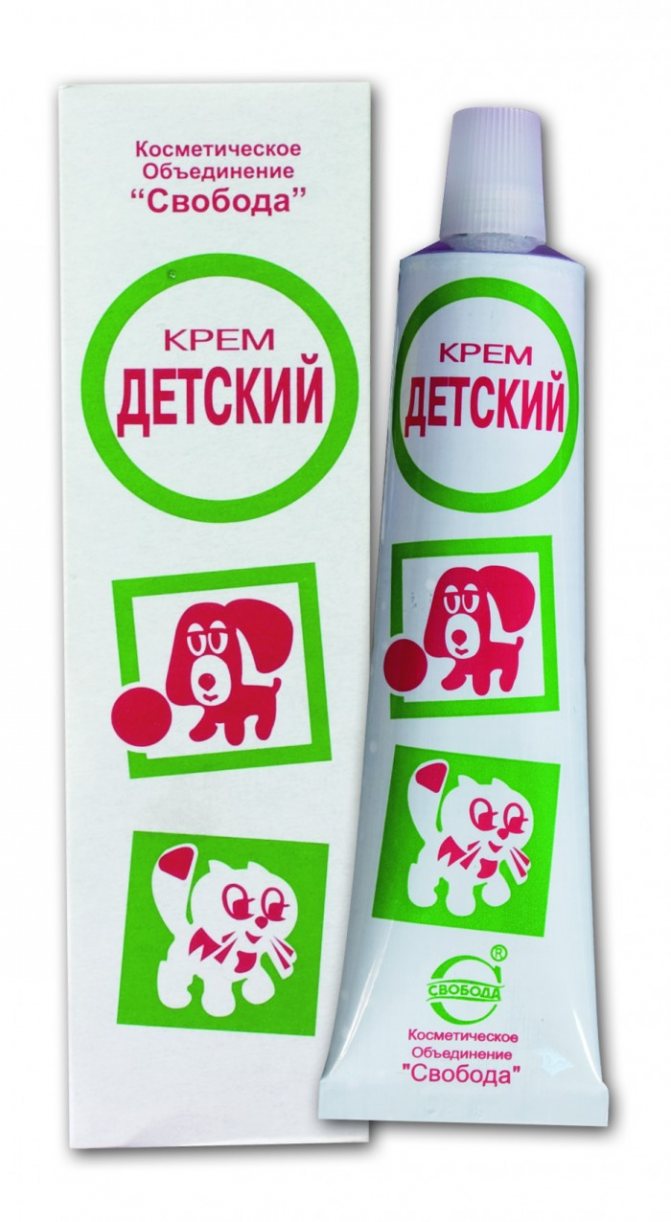
Treatment of a condition where the skin of a child’s hands peels off
When a child has peeling skin on his legs, the first step is to treat the disease that caused the desquamation. If peeling of the skin is caused by other factors (vitaminosis, frostbite, radiation), then it is necessary to help the skin recover as quickly as possible. To do this, first of all you need to adjust your diet. It is necessary to introduce into the baby’s daily menu as many foods as possible rich in vitamins A and E. These vitamins are found in cereals (barley, rye, corn, oats), potatoes, fish oil, liver, eggs, peaches, apricots, plums, dried apricots, prunes , carrots, pumpkin, cabbage, dill, parsley and cilantro.
When preparing meals for your child from foods rich in vitamins A and E, do not forget that these vitamins are fat-soluble and are fully absorbed by the body only in the presence of fats of plant or animal origin. Therefore, it is recommended to add a little sour cream or butter to your food.
In most cases, when a child has peeling skin on his legs and arms, eliminating the imbalance of nutrients in the growing body is the main method of treating this disease. In winter, when it is problematic to include vegetables and fruits rich in essential vitamins in a child’s daily diet, it is worth consulting with a pediatrician about the advisability of taking children’s multivitamin complexes.
In addition to treating peeling skin on the hands and feet by taking vitamins A and E, due attention must be paid to hygiene procedures to prevent scratching areas from becoming infected. It is recommended to bathe your baby daily, carefully removing dried crusts from the skin. Among the folk remedies for treating cases where a child has peeling skin, you can use hand and foot baths with decoctions of celandine, string, oak bark, and chamomile. Moreover, after water procedures, damaged areas of the skin should under no circumstances be wiped, only lightly “blot” with a soft towel. Then you need to lubricate the damaged areas of the skin with baby moisturizer. It is better if the cream contains vitamins A and E. Pharmacies sell children's multivitamin creams containing not only vitamins, but also moisturizing oils, for example, Bübchen, Boro-plus, Bepanten, Radevit. You can buy oil solutions of vitamins A and E at the pharmacy, mix them and treat the peeling areas with them.
Also, caring parents should not forget to trim their child’s nails regularly, at least once every 7 days. And make sure that there is no dirt under the nails, since when scratching the places where the child’s skin is peeling, he can introduce an infection into the wound.
Treatment methods
Traditional treatment methods and folk remedies will help combat the problem.
Medication
The reason for peeling lies in the lack of vitamins. This happens in winter, spring or after an illness. The body has exhausted its vitamin resources and they urgently need replenishment. Contact your doctor, he will help you determine the missing elements. Skin problems arise when there is a lack of vitamins A and E. Purchase a vitamin complex that is appropriate for the child’s age.
The skin on your baby's fingers may peel off due to a fungal disease. At risk are children who visit a public swimming pool, run barefoot on the street and play with animals. In addition to peeling, itching will appear in areas of fungal infection. At the first signs of illness, you should consult a doctor. Don't ignore the symptoms. The specialist will prescribe ointments - Terbizil or Exoderil. Self-medication leads to aggravation of the situation. Subsequently, the nail will fester, making home treatment impossible, and hospitalization will be required.
Traditional methods
Traditional medicine recipes will help if your child’s feet are peeling. It effectively fights the disease that occurs on the leg. Using folk remedies will moisturize the pads of your heels, and the disease will pass unnoticed.
The suggested recipes will help if the baby’s skin begins to peel off:
- Take 100 ml castor oil and heat it in a water bath. If desired, you can use olive or any other. Mix the heated oil with a whisk with two yolks. Apply the mixture to the damaged surface, wrap it in polyethylene, and put a wool sock on top. Leave for 40 minutes, then rinse with running water and laundry soap.
- Prepare a chamomile decoction, mix it with a few tablespoons of cream and starch. Mix everything into a homogeneous mass. Apply the resulting product overnight. In the morning, rinse and apply moisturizer.
- Use baths from various medicinal plants - calendula, chamomile, string, nettle. These plants, according to reviews, allow you to get rid of problems, the skin will stop flaking, and all spots on the surfaces of the legs will disappear.
These methods will help if there are no serious health problems. The baby’s skin on his limbs will no longer peel and crack, and his heels will no longer peel off. To determine the diagnosis, consult a specialist.
Why the skin on your hands peels off: reasons and recommendations
Today, quite a lot of people have peeling skin on their hands; they mistakenly try to eliminate the causes of this condition with the help of cosmetics. In fact, when various creams and lotions do not have the desired effect, the problem may lie not in dry skin, but in a lack of vitamins or allergies.
Today we will try to figure out why the skin on our hands peels off, that is, we will analyze the main reasons for this condition, and also consider effective methods of combating this problem.
If you believe research conducted by the British, a person pays attention to his own hands about 150 times a day. This means that the slightest noticeable changes in the limbs will be detected at the initial stage. And after identifying the problem, attention to the upper extremities increases 2-3 times, since a person will try to hide his hands from prying eyes, because sometimes it is the condition of the skin that can spoil the image.
The reasons that cause peeling of the skin of the hands can be different. This condition may be the result of exposure to certain factors on the skin of the hands.
For example, using aggressive household chemicals without gloves. The condition may also be seasonal, caused by a deficiency of vitamins and beneficial microelements.
In general, experts attribute the following to the main causes of peeling skin:
1. Infection with staphylococci or streptococci has occurred. This provokes an inflammatory process in the skin, which causes small bubbles to form on the surface, which subsequently burst, leaving scales. 2. Irradiation of the body. 3. Dermatoses. 4. Taking antibacterial medications for a long time. Often the skin begins to peel off as a result of long-term use of drugs from the sulfonamide group. 5. Taking hormonal drugs also causes peeling of the skin, especially if the course of use is long. 6. Damage to the body and separately the skin by viruses. 7. The influence of low temperatures on the cover. 8. Stress and nervous disorders. 9. Helminth infestations. 10. Disorders and diseases of the pancreas. 11. Allergies. 12. Lack of vitamins and beneficial microelements, especially A and E. 13. Fungal diseases.
Of all the reasons given above, it is recommended that you familiarize yourself with the last three factors in more detail.
Sources:
http://fb. ru/article/213679/u-rebenka-na-paltsah-ruk-oblazit-koja-prichinyi-i-lechenie
http://ymadam. net/deti/zdorov-e-rebenka/u-rebenka-oblazit-kozha-na-paltsakh. php
http://psoriazinform. ru/dermatitis/dermatitis-symptoms/oblazit-kozha-na-rukax-prichiny-2.html
Rough spots on a child's body
- The appearance of rough patches of skin is a fairly common phenomenon among children in the first three years of life. If you find rough spots with a small reddish rash on your child’s body, most likely you are dealing with atopic dermatitis
- At the same time, in the morning while sleeping, the rash may be invisible and dry, rough skin can only be detected by touch. Spots may appear on different parts of the body, most often on the cheeks, arms or legs. During exacerbations, particularly in winter, the spots become irritated, red and raised
- Atopic dermatitis may be caused by a hereditary immune system that reacts to allergens in food and the environment, as well as a genetic predisposition to dry skin
- Atopic skin needs special care and hydration. In addition, an important role is played by the need to eliminate the allergen, follow a diet and carefully select cosmetics, clothing and everything that comes into contact with the child’s skin.
More information about atopic dermatitis can be found in the article Diet for atopic dermatitis in a child. Modern and traditional treatment of atopic dermatitis in children
Rough or dry skin can also be a consequence of dry air, chlorinated water, abuse of herbal decoctions when bathing, lack of moisture in the body, etc.
